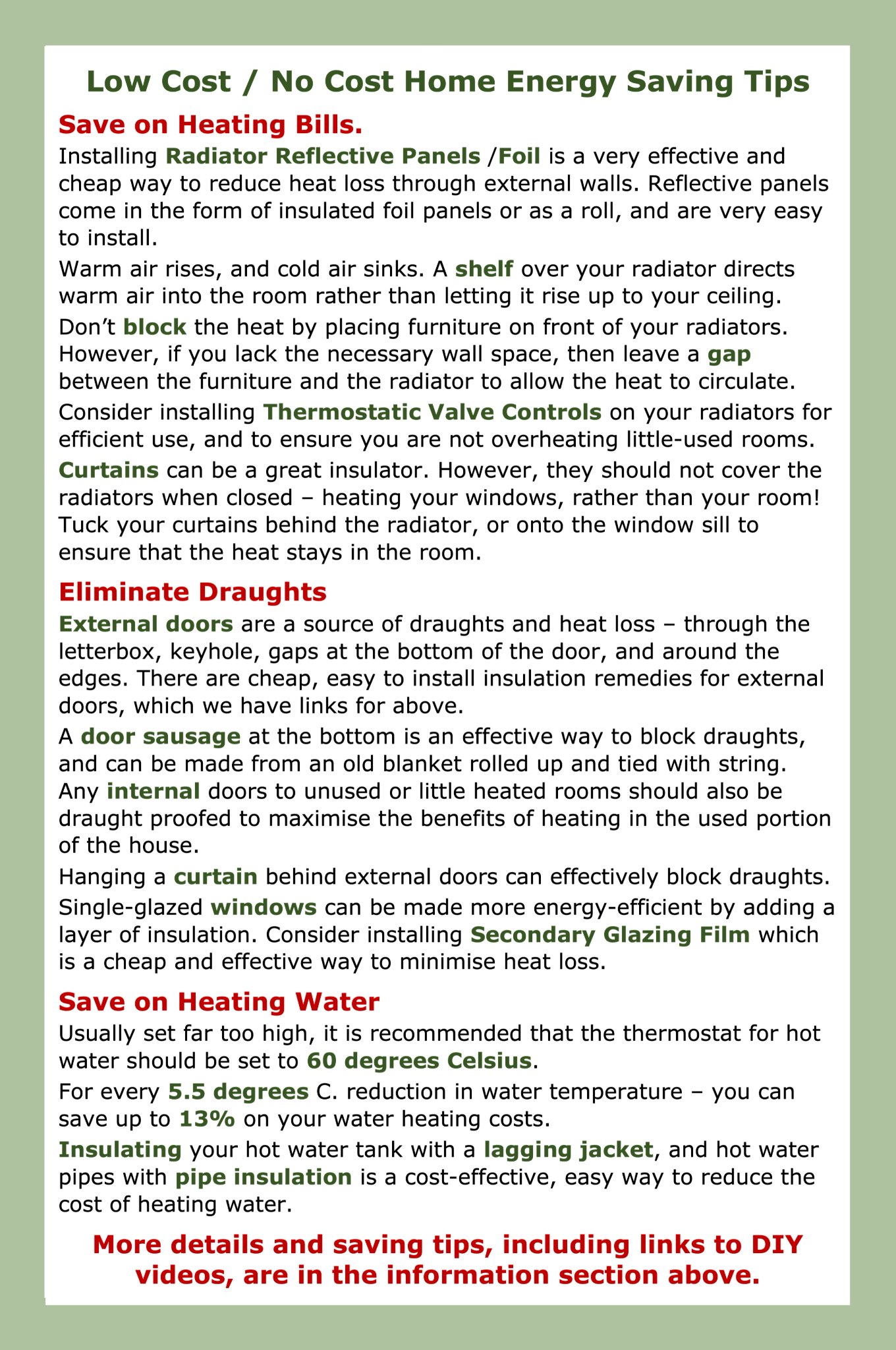
Low cost / No cost Energy Saving Tips
With energy costs rising by the day, it is more important than ever that we try and reduce energy waste. There are “no-cost” and “low-cost” ways to keep our homes warm while cutting down on the amount of energy we use – helping both our pockets, and the planet.
Here we have links and further information on some cheap, effective DIY ways that you can reduce your energy costs.
Draught-proofing
One efficient and cost-effective way to reduce heat-loss in the home is by taking draught-proofing measures.
While all homes need good ventilation to reduce condensation and damp, draughts are a waste of heat and money – but there are simple cost-effective ways to prevent draughts, and help keep your home warm.
This short-video shows how to locate draughts in your home, with some DIY tips to seal them: www.youtube.com/watch?v=PQ9DSxfaS94
This is an informative page on draughts and ventilation with useful links: www.transitioncambridge.org/wiki/TTEnergy/VentilationFAQ
This is a short video with a good general overview of draught-proofing: www.youtube.com/watch?v=BljYyfecxRw
This is a short DIY video on installing draught-excluders, including brush-strip, surround seal, and letterbox seal, on your windows and front door. www.youtube.com/watch?v=hWJ8J5c0LE8&t=3s
Skirting boards can be another source of draughts. This is a short video showing you how to draught-proof your skirting boards: www.youtube.com/watch?v=ZZozybgIZ6U
The impact of under-door draughts should not be underestimated!
A ¼ inch wide gap under your front door will waste about the same amount of heat as if you had a 2" square hole in the wall!
A tried and trusted way to exclude draughts is to use a door “sausage” or door “stopper” to block draughts and keep the heat in the room. Door “sausages” can be easily made by rolling up and tying old blankets. But there are many cheap, easy, and colourful ways to make them. This video shows 17 different types of homemade door “sausages” with links to pages with instructions – including “no-sew” versions. www.youtube.com/watch?v=SI3S9IfJy1U
Windows
Windows are often a source of cold and draughts in houses. However, there are some easy steps that can be taken to minimise heat loss through windows.
Curtains are still one of the most effective ways to regulate heat in your home. Open your curtains to maximise heat gain from the sun (when it shines!) and reduce heat loss at night by closing them. Ideally, curtains should be lined to maximise their effect.
During the day, doors to rooms that benefit from passive solar heat should be opened to allow the heat to circulate to the rest of the house.
Tucking your curtains behind the radiator, or onto the window sill will ensure that the heat stays in the room. Another way to stop curtains blocking radiator heat is to attach net-curtain wire with hooks and eyes under the edge of the window sill, and tuck the curtains behind the wire so that the heat goes into the room rather than between the curtains and window.
There are a number of cheap and effective methods of blocking draughts from your windows such as weather-proofing tape. This video shows how to draught-proof a hinged window. www.youtube.com/watch?v=Qw8bBZx19yY
Single-glazed windows can be made more energy-efficient by installing Secondary Glazing Film – for example the Irish-made Exitex – which is a cheap and effective way to minimise heat loss. It is widely available from hardware stores, and online. This short video shows how easy it is to install Secondary Glazing Film as a DIY job: www.youtube.com/watch?v=_IYuEI6mLRw&t=3s
Radiators
Thermostatic Valve Controls/ Thermostatic Radiator Valves are a very effective way to control the heat in a room, but there is a lot of confusion about how they work. We have linked to a very informative and useful video about TRVs here: www.youtube.com/watch?v=_d5-OzlOah0
Radiator Reflective Panels /Foil are a very effective and cheap means to reduce heat loss through external walls. Reflective panels come in the form of insulated foil panels or as a roll, and are very easy to install. Here is a short video showing how it is done: www.youtube.com/watch?v=48co8eLBUmg
Reflector panels/foil are widely available in hardware shops and DIY stores, and online.
Insulation
Insulation is key to a warmer home, and reducing energy costs. There are small DIY insulation projects that are cheap and easy to carry out either by yourself, or with a little help.
Insulating your hot water tank with a lagging jacket, and hot water pipes with pipe insulation is an easy way to reduce the cost of heating water. This short video shows how to install pipe insulation: www.youtube.com/watch?v=Ko4yYx_OwOc
Water thermostats are usually set far too high – typically to 80 degrees Celsius and sometimes higher – which is costly in terms of both money and energy, but with no added benefit. It is recommended that the thermostat for hot water should be set to 60 degrees C. For every 5.5 degrees C. reduction in water temperature you can save up to 13% on your water heating costs.
General links:
While the focus of this post is on no cost/low cost DIY tips, if you are considering more substantial insulation works, then the SEAI have a range of grants available for homeowners. www.seai.ie/grants/home-energy-grants/insulation-grants/
Attic insulation is one of the most cost-effective ways to reduce heat loss from your home – and will typically pay for itself within a year, or two at most. The SEAI have an information pack on attic insulation available: www.seai.ie/publications/Homeowners-Guide-To-Attic-Rafter-Insulation
This is a good general information page with lots of technical advice about heating controls, thermostats, and radiators. www.transitioncambridge.org/wiki/TTEnergy/HeatingFAQ
This is a useful webpage with a good general overview on draught-proofing: https://energysavingtrust.org.uk/advice/draught-proofing/
Useful page with a number of no-cost, ways to reduce your energy bills.
www.turningtogreen.com/post/no-cost-ways-to-reduce-your-energy-bills

